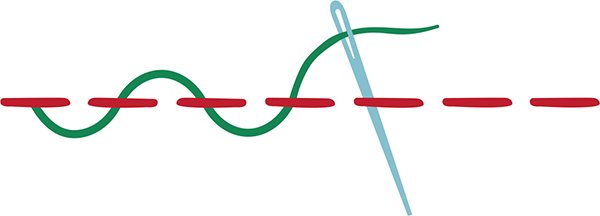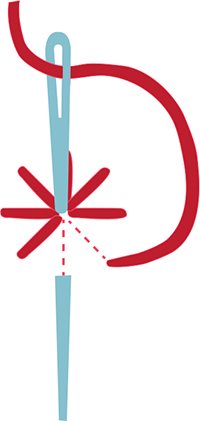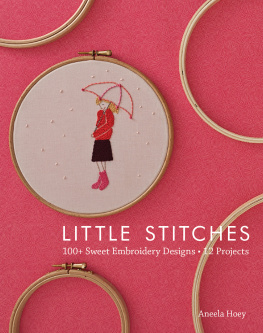Contents
Guide
BIG
EMBROIDERY
20 crewel embroidery designs to stitch with wool
NANCY NICHOLSON

www.sewandso.co.uk
CONTENTS
In memory of Biddy.
INTRODUCTION
This is a book of ideas for using knitting and tapestry wool (yarn) for embroidery instead of the finer threads that youd normally associate with this type of needlework. The skills and stitches required are much the same as with traditional embroidery, so if youre already an experienced embroiderer, you wont be starting from scratch. But chunkier threads mean you will be working on a larger scale, and youll find that these projects are a great way to introduce beginners, including children, to the pleasures of hand-stitched embroidery.
Indeed, behind all the projects is the desire to share the joy of taking something familiar and giving it a new twist. For many of the projects Ive used wool embroidery to embellish, customise and transform everyday garments knitwear, jeans, slippers as well as blankets, too. But there are ideas for making your own projects also, from belts to bags, cards to cushions, and purses to pictures. I have used leftover knitting and crochet yarns for many of the projects and the results are just as detailed and intricate as using traditional embroidery threads.
Above all, I want you to use these projects as a source of inspiration rather than as a rule book. While I have provided Embroidery Suggestions throughout for the designs as I have stitched them, I urge you to experiment, to combine stitches and motifs to create your own unique results. Just relax and enjoy your growing confidence. Remember, you can always unpick and start a small area again I do this all the time!
With a comprehensive Stitch Library to refer to and motif spreads to inspire you, I hope you will apply your ideas to different textiles around your home, to any fabric where the weave is loose enough to accommodate the larger threads. Heres an invitation to play, to explore these pages and take the ideas into new places, just as Ive done. Its an invitation to have some fun, so think big!

TOOLS AND MATERIALS
WOOL (YARN) AND OTHER THREADS
Knitting wool: I have most often used double knitting wool and sometimes a slightly finer 4-ply (fingering) wool, usually leftovers from knitting or crochet projects.
Tapestry wool: I use Anchor or Appletons yarn in either 2-ply or 4-ply. Tapestry wools are sold in skeins in many beautiful colours, but always start from your stash of leftovers. (You can often find unwanted embroidery kits or other remnants for very little money in charity shops.)
Laceweight wool: Whenever you want to embroider something more delicate this finer yarn is a good choice. Ive used it for the embroidery on the mittens and the sash belt.
Fine crewel wool: Often provided in traditional shop-bought embroidery kits, this type of yarn is very similar to laceweight wool in the effect it gives.
Other threads: Dont be limited by the suggestions above. Once you have gained confidence by completing some of the projects here, allow yourself some freedom to experiment with ribbon, fabric strips and even string.
FABRICS
You can embroider on just about anything, so take a look at what you have to hand and experiment. Basically, if a needle will go through it, you can embroider it.
For the embroideries onto felt, I have used a heathered felt that has a marled effect, so the colours are much more subtle than with nylon felts (see ). For the embroideries onto fabric, Ive mostly used a heavyweight woollen or linen fabric.
Listed below are some suitable fabrics for big embroidery. They need to be a heavier weight than for ordinary embroidery and will usually be found in the upholstery section of fabric shops.
- Heavyweight woollen fabric
- Tweeds
- Heavyweight linen fabric (upholstery weight with an open weave)
- Boiled wool
- Thick felt
- Knitwear
NEEDLES
While it is always good to have a variety of needles in your sewing box, the types of needle you are most likely to use when working with wool (yarn) are tapestry and chenille. Clearly, your needle will need an eye large enough for the wool (yarn) you are using. Ive used chenille size 21 mostly, but try a tapestry needle if you prefer a blunter end. Experiment until you find the one you like.
SCISSORS
Youll need a collection of good-quality scissors: a pair of general purpose scissors for cutting paper templates; a pair of dedicated fabric cutting scissors; and sharp embroidery scissors for snipping threads.
PATTERN TRANSFER TOOLS
Heat-erasable pen: I use a Pilot Frixion pen for marking lines that are to be covered with embroidery stitches. These pens are available in many different colours, so its easy to make a readable mark on both light and medium shade fabrics (it will not be successful if the fabric is too dark). Unlike an air-erasable pen, the marks will last until you complete your embroidery, but are easily removed by covering with a damp cloth and ironing over when the line magically disappears.
Air-erasable pen: Use this type of pen where you need to mark temporary guidelines with a ruler for accurate placing of the design motifs (where the lines are not intended to be stitched over) the lines will quickly disappear without leaving a mark.
STITCH
LIBRARY

Running Stitch


Laced Running Stitch


Double Laced Running Stitch


Eskimo Stitch


Star Stitch


Straight Stitch




















